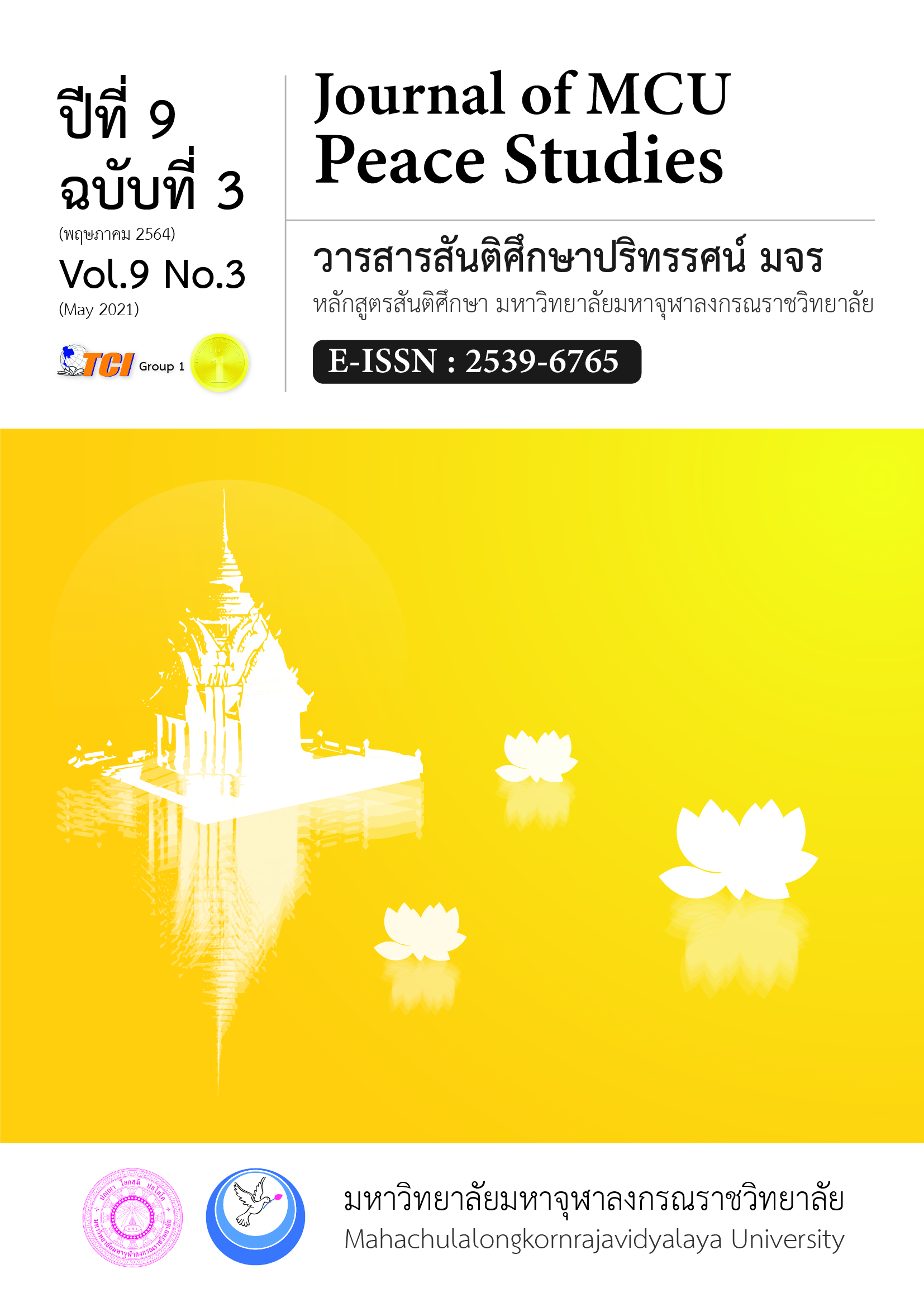The Development of Peace Indicators and Measurement of Levels of Peace in Thai Society B.E. 2563
Main Article Content
Abstract
Although the levels of global peace measurement provides the comparison information at the national level, still there is a lack of information at the regional or provincial level, including the context of Thailand whether on economy, society, cultures, and politics. The research article aimed at 1) developing the peace indexes and indicators suitable for Thai society, 2) measuring the levels of peace in Thai society in order to formulate suggestions for peacebuilding. This study was conducted in the 2nd phase of year B.E. 2563 (by which the data was collected in year B.E. 2562). The study was both quantitative and qualitative research in which the indicators were produced at both the national and provincial levels. The data sources used were statistical data from relevant agencies that had been continuously collected and the data from the nationwide opinion polling which was collected by the National Statistical Office in a total number of 33,420 persons. The indexes were calculated under the framework of Organization for Economic Co-operation and Development (OECD) including Ebert and Welsh. The data on the peace levels in Thai society at both national and provincial levels were presented. The research results showed the results of a comparative study between year B.E. 2560 and B.E. 2562, it was found that the levels of peace index in Thailand of year B.E. 2560 that had a point of 3.42 was higher than year B.E. 2562 that had a point of 3.36. The calculation of the overall peace levels at the provincial level, it was conducted by which the provinces were divided into 5 groups with the highest and lowest levels of peace. The research results could be used for collaborative learning in educational institutions, as well as the formulation of the policy of relevant agencies in the field of peace.
Article Details
Views and opinions expressed in the articles published by The Journal of MCU Peace Studies, are of responsibility by such authors but not the editors and do not necessarily reflect those of the editors.
References
Department of Economic and Social Affairs of United Nations. (2020). World Social Report 2020. Retrieved July 12, 2020, from https://www.un.org/development/desa/publications/world-social-report-2020.html
Department of State United States of America. (2019). Trafficking in Persons Report. Retrieved July 15, 2020, from http://www.state.gov/wpcontent/uploads/2019/06/2019-Trafficking-in-Persons-Report.pdf
Ebert, U., & Welsch, H. (2004). Meaningful environmental indices: A Social Choice Approach. Journal of Environmental Economics and Management, 47(2), 270-283.
Freedom House. (2020). Freedom in the World. Retrieved August 2, 20202, from https://freedomhouse.org/sites/default/files/2020-02/FIW_2020_REPORT_BOOKLET_Final.pdf
Galtung, J. (1996). Peace By Peaceful means: Peace and Conflict, Development and Civilization. Oslo: International Peace Research Institute.
Institute for Economics and Peace. (2019). Covid19 and Peace. Retrieved July 23, 2020, from http://visionofhumanity.org/app/uploads/2020/06/COVID19-and-Peaceweb.pdf
________. (2019). Global Peace Index 2019: Measuring Peace in a Complex World. Retrieved July 23, 2020, from http://visionofhumanity.org/app/uploads/2019/07/GPI2019web.pdf
________. (2019). Positive Peace Report 2019: Analysing the Factors that Sustain Peace.Retrieved July 23, 2020, from http://visionfhumanity.org/app/uploads/2019/10/PPR-2019-web.pdf
________. (2019). Global Terrorism Index 2019: Measuring the Impact of Terrorism. Retrieved July 23, 2020, from http://visionofhumanity.org/app/uploads/2019/11/GTI2019web.pdf
Institute for Justice and Reconciliation. (2019). SA Reconciliation Barometer Survey. Retrieved July 23, 2020, from https://www.ijr.org.za/portfolio-items/sa-reconciliationbarometer-2019
Inter-Agency and Expert Group. (2017). Report of the Inter-Agency and Expert Group on Sustainable Development Goal Indicators (Revised List of Global Sustainable Development Goal Indicators). Retrieved August 5, 20202, from https://unstats.un.org/sdgs/indicators/Official%20Revised%20List%20of%20global%20SDG%20indicators.pdf
King Prajadhipok's Institute and National Statistical Office. (2019). Public Opinion Survey Report on Satisfaction with Public Service and Operation of Various Agencies B.E. 2562. Bangkok: Research and Development Division.
National Statistical Office. (2015). Thailand Poverty Maps Whole Kingdom. Bangkok: National Statistical Office.
________. (2019). The Labor Force Survey Whole Kingdom Between B.E. 2560 – 2562. Bangkok: National Statistical Office.
Office of the National Economic and Social Development Council. (2019). Human Achievement Index of Year 2562. Bangkok: Office of the National Economic and Social Development Council.
Organisation for Economic Co-operation and Development. (2008). Handbook on Constructing Composite Indicators: Methodology and User Guide. Paris: OECD Publishing.
Ramsbotham, O., Miall, H., & Woodhouse, T. (2011). Contemporary Conflict Resolution. UK: Polity Press.
The Legatum Institute Foundation. (2019). The Legatum Prosperity IndexTM: A Tool for Transformation 2019. Retrieved August 5, 2020, from https://www.prosperity.com/download_file/view_inline/3690
The World Justice Project. (2020). The World Justice Project Rule of Law Index 2020. Retrieved August 9, 2020, from https://worldjusticeproject.org/sites/default/files/documents/WJP-ROLI-2020-Online_0.pd

